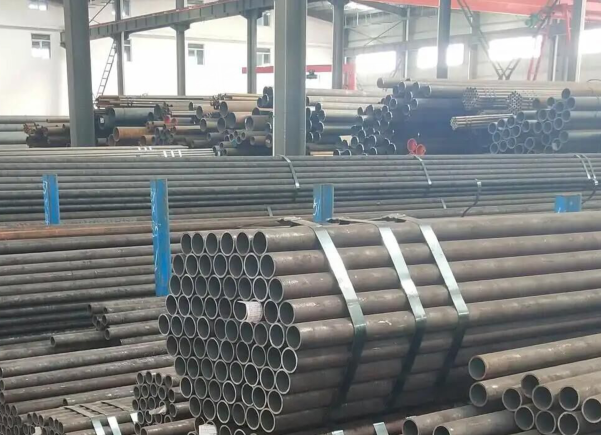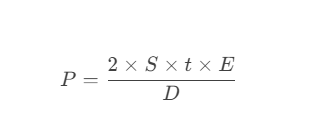The "pressure rating" of Carbon Steel (CS) Seamless Pipe is not a single fixed value, but is determined by the pipe's material, outer diameter, and wall thickness. Simply put, for seamless pipe of a specific material and size, its wall thickness directly determines the pressure rating it can withstand.
In industry, particularly in the petroleum, chemical, and power industries, the pressure rating of carbon steel seamless pipe is often indicated by a "Schedule," with the most common being Sch40, Sch80, and Sch160. The Schedule represents the pipe's wall thickness series, and its definition is related to factors such as the pipe's allowable stress and design pressure.

The larger the number after the Schedule, the thicker the wall and the higher the pressure it can withstand.
Sch10S / Sch10 - Thin Wall
Sch40 / STD - Standard Wall Thickness (commonly used in standard pressure piping)
Sch80 / XS - Extra Thick Wall Thickness (commonly used in higher pressure piping)
Sch160 - Extra Thick Wall Thickness (used in high pressure piping)
Note: For pipes with the same designation (e.g., Sch40), the actual wall thickness varies between pipes with different nominal diameters (DN). For example, the absolute wall thickness of a DN50 Sch40 pipe and a DN200 Sch40 pipe differ significantly, yet they belong to the same wall thickness series and have similar proportional strength.
Common Standards and Materials:
The production and pressure ratings of seamless carbon steel pipes follow international or national standards. Common standards include:
ASME/ANSI B36.10M: Seamless and welded steel pipes (American standard, most commonly used)
GB/T 8163: Chinese standard "Seamless Steel Pipes for Fluid Transportation" (commonly used for medium and low-pressure fluid transportation)
GB/T 5310: Chinese standard "Seamless Steel Pipes for High-Pressure Boilers" (used in high-temperature and high-pressure environments)
Common carbon steel grades:
ASTM A106 Gr. B: Seamless carbon steel pipe for high-temperature service, most commonly used.
ASTM A53 Gr. B: Seamless and welded steel pipe, widely used, with slightly lower performance than A106.
Chinese standard #20 steel: Equivalent to ASTM A106 Gr. B, the most commonly used material in GB/T 8163.
How is the pressure rating determined?
Theoretically, the pressure a seamless pipe can withstand can be calculated using a formula. The most commonly used formula is derived from the internal pressure wall thickness formula in ISO 15649 or ASME B31.3 (process piping):
Pressure calculation formula:

Where:
P = Maximum allowable working pressure (MPa or psi)
S = Allowable stress of the pipe (MPa or psi) - This is a core parameter determined by the material and temperature. For example, the allowable stress S of A106 Gr.B at room temperature is approximately 138 MPa (20,000 psi).
t = Minimum wall thickness of the pipe (mm or inches)
D = Outside diameter of the pipe (mm or inches) - Note: This is not the nominal diameter (DN)
E = Quality factor (usually 1.0 for seamless pipe)
How to select carbon steel seamless pipe?
1. Determine design parameters: First, know the required design pressure and temperature for your system.
2. Select material: Select an appropriate carbon steel grade (such as A106 B) based on the fluid properties, temperature, and pressure. As the temperature rises, the material's allowable stress decreases, which is crucial for material selection.
3. Determine Pipe Diameter: Calculate the nominal diameter (DN) and outside diameter (D) based on the flow rate and velocity.
4. Calculate Wall Thickness/Use a Table:
Calculate: Use the above formula, substituting the design pressure, outside diameter, and material's allowable stress, to reverse-calculate the required minimum wall thickness t.
Use a Table: Based on the calculated minimum wall thickness, compare it to the
ASME B36.10M wall thickness table (Schedule Table) and select a schedule number with an actual wall thickness no less than the calculated value. For example, if the calculation requires 4.0mm, and the wall thickness of Schedule 40 is 4.55mm, then select Schedule 40 pipe.
5. Consider Safety and Corrosion Allowances: In actual engineering, corrosion allowances (CA) and safety factors are added to theoretical values during calculations to ensure pipe life and safety.
Conclusion:
The pressure rating of carbon steel seamless pipe depends on the material, outside diameter, and wall thickness. When selecting a pressure rating for carbon steel seamless pipe, factors such as the pipe's operating environment, operating conditions, and operational requirements must be considered. The appropriate pressure rating should also be selected based on a combination of factors, including the pipe's intended use and functional requirements. If the pressure rating is too low, the pipe may not be able to withstand the operating pressure, leading to safety issues such as leakage and damage. If the pressure rating is too high, it may waste resources and increase maintenance costs.
Read more: Carbon Steel Pipe Material and Classification



